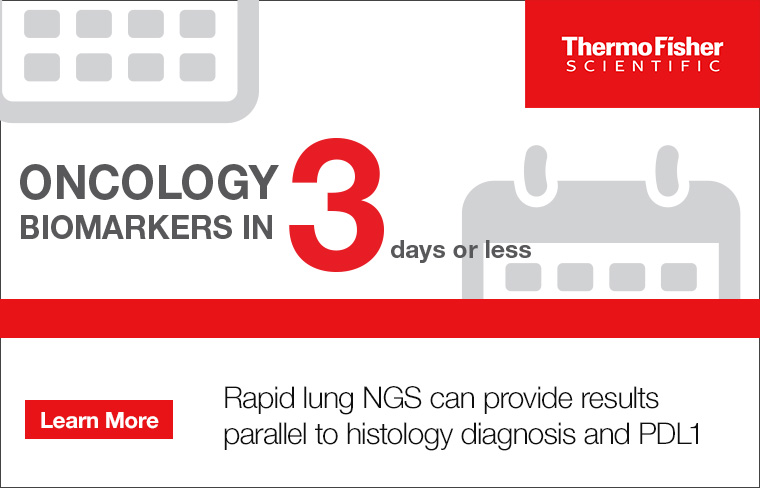Sponsored Content

Based on several published analysis, the availability of genomic profile for 1st Line therapy decisions has impact on NSCLC patient outcomes1,2
Rapid Lung Next Generation Sequencing (NGS) delivers complete actionable biomarker results in as fast as 3 days

According to real-world data analyses of clinical gaps in NSCLC patient management, Turn Around Time (TAT) to complete actionable biomarker result is one of the main barriers to access of patients to precision oncology treatments, especially in NSCLC3.

Hospitals which implemented in-house Rapid Lung NGS have successfully overcome this barrier, empowering oncologists with complete combined PDL1 and genomic biomarker actionable profile in 3-5 days4.
Ask your pathologist about rapid lung NGS!
Learn more at oncomine.comRead & listen to experience of your peers with Rapid Lung NGS:
Interview Article
The Need for Rapid Lung NGS
In this short article Lauren Ritterhouse, MD, PHD; at the time from Massachusetts General Hospital Department of pathology and Center for Integrated Diagnostics talks about how in-house rapid NGS improved their TAT and sample reporting success rates, and what difference this can make for NSCLC patients.
On-Demand Webinar
Community-Based Rapid NGS Offers Considerable Advantages in Clinical Cancer Care
In this webinar, Dr. Brandon Sheffield, MD of Canada‑based William Osler Health System shares the organization’s experience with implementing next‑generation sequencing (NGS) in routine oncology biomarker testing.
In their pilot study, 578 solid tumor samples underwent genomic profiling. All testing was performed by one group of technologists within the same division of the laboratory, achieving a median turn‑around time (TAT) of 3 business days.
On-Demand Webinar
Rapid Lung NGS is empowering clinicians and reducing biomarker testing costs
In this webinar, Ibiayi Dagogo Jack, MD. Thoracic Oncologists and article Lauren Ritterhouse, MD, PHD; from Massachusetts General Hospital Department of pathology and Center for Integrated Diagnostics describe their integrated and rapid NSCLC biomarker testing system, including integration of radiology, pathology and pharmacy with oncology, and the impact they see on time to treatment and also patient outcomes.
- Compromised Outcomes in Stage IV Non–Small-Cell Lung Cancer With Actionable Mutations Initially Treated Without Tyrosine Kinase Inhibitors: A Retrospective Analysis of Real-World Data, Scott et al; JCO Oncol Pract 00:1-9 © 2023 by American Society of Clinical Oncology
- Association Between Availability of Molecular Genotyping Results and Overall Survival in Patients With Advanced Nonsquamous Non–Small-Cell Lung Cancer, Aggarwal et al; JCO Precis Oncol 7:e2300191 © 2023 by American Society of Clinical Oncology
- Impact of Clinical Practice Gaps on the Implementation of Personalized Medicine in Advanced Non–Small-Cell Lung Cancer, Sadik et al; JCO Precis Oncol 6: e2200246. © 2022 by American Society of Clinical Oncology
- Integrated Radiology, Pathology, and Pharmacy Program to Accelerate Access to Osimertinib, Dagogo-Jack et al; JCO Oncol Pract 00:1-7 © 2023 by American Society of Clinical Oncology

